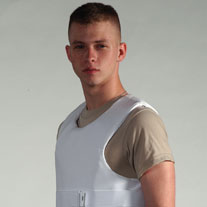Stab proof vest facts for kids
A stab-proof vest (also called a stab vest) is a special type of body armor that helps protect people like police officers and prison guards. It's designed to keep them safe from sharp objects, such as knives or broken glass, during their work. Think of it like a shield you wear!
Contents
What is a Stab-Proof Vest?
A stab-proof vest is a piece of clothing that people wear to protect their body, especially their chest and back, from sharp objects. Unlike bulletproof vests, which stop bullets, stab vests are made to resist punctures and cuts. They are an important part of the safety gear for many people who work in jobs where they might face danger.
How Do Stab Vests Work?
Stab vests work by spreading out the force of a sharp object over a larger area. They are made from special materials that are very strong and tightly woven. When a knife or other sharp item tries to push through, the vest's material catches the point and stops it from going all the way through to the body. It's like trying to push a needle through a thick, strong blanket – it's much harder than pushing it through a thin piece of paper.
Materials Used
Modern stab vests often use layers of strong, flexible materials. Some common materials include:
- Aramid fibers: These are very strong synthetic fibers, like those used in Kevlar. They are woven together tightly to create a tough barrier.
- High-performance polyethylene (HPPE): This material is also very strong and lightweight. It's often used in multiple layers to provide protection.
- Laminated fabrics: Sometimes, different layers of materials are pressed together to make the vest even stronger and more resistant to sharp points.
These materials are chosen because they are hard to cut or pierce, but they also need to be light enough for people to wear comfortably during their work.
Who Wears Stab Vests?
Many different professionals wear stab vests to stay safe while doing their jobs. The most common wearers include:
- Police officers: They wear vests to protect themselves when responding to calls or dealing with situations where sharp objects might be involved.
- Prison guards: These vests are essential for guards who work in prisons, as they help protect them from attacks by inmates.
- Security guards: People working in security, especially at events or in places where there might be risks, often wear stab vests.
- Emergency medical services (EMS) workers: Sometimes, paramedics or ambulance staff wear vests if they are going into situations that might be unsafe.
Wearing a stab vest helps these brave individuals do their jobs with more confidence, knowing they have an extra layer of protection.
History of Protective Vests
People have been trying to protect themselves from sharp weapons for thousands of years. Early forms of body armor were very different from today's stab vests.
Early Armor
In ancient times, warriors wore armor made from materials like leather, bronze, or iron. These early types of armor, such as chainmail or plate armor, were designed to protect against swords, spears, and arrows. While they offered good protection, they were often very heavy and hard to move in. Over time, as weapons changed, so did the need for different types of armor.
Modern Developments
The idea of flexible, lightweight body armor began to develop more in the 20th century. Scientists and engineers started creating new materials that were strong but also comfortable to wear. The first modern bulletproof vests appeared in the mid-1900s, and soon after, specific vests designed to stop knives and other sharp objects were developed. These advancements have made it possible for many more people to wear protective gear every day.
Why Are Stab Vests Important?
Stab vests are incredibly important because they help keep people safe in dangerous jobs. They reduce the risk of serious injuries or even death from attacks involving sharp objects. By protecting police officers, prison guards, and other frontline workers, these vests help them do their jobs effectively and return home safely to their families. They are a vital tool for personal safety in many professions around the world.


